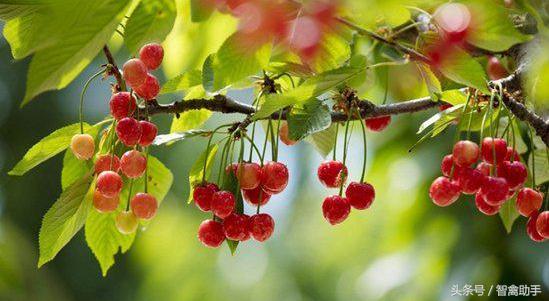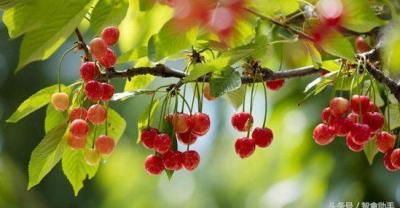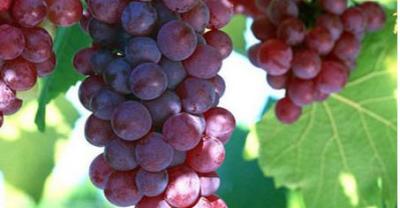How to plant cherry trees?
Cherry is very popular with consumers because of its bright color and beautiful crystal. With the popularization of greenhouse planting technology, the use of greenhouse technology to grow cherries has also been welcomed by farmers. Cherry in greenhouse has less investment and high output value. If cultivated in greenhouse in early spring, cherry can be put on the market in advance and considerable economic benefits can be obtained. So, how to plant cherry trees? The cultivation and management of cherry in greenhouse are introduced as follows.

Picture: Cherry tree
I. Construction of greenhouse in Cherry Orchard
1. Garden selection: choose loam or sandy loam with leeward facing sun, sufficient light, flat terrain, convenient drainage and irrigation and loose soil when building the shed. According to the heat dissipation of the shed, the area of the greenhouse should be 300-400 square meters, and it should be built in the east-west direction with a single slope.
two。 Greenhouse construction: in order to reduce costs, soil can be used to hit the north wall, the east-west wall is 3 meters high and 3.5 meters high from the north wall, supported by plaster strips (with steel bars). The south wall is 2.5 meters high, with work doors and ventilation windows on the east and west walls. The window is 1.5 meters high from the ground, and the north and south walls are glued with mud (except the window), which is used to prevent cold and heat preservation. In the shed, the gypsum strip (with steel bar) is used as the main column, and the row spacing is 3.5 meters. Bamboo is used as the skeleton above the column, connecting the south wall and the north wall, tied into a square of 50 cm, covered with no dripping film, and covered with a layer of grass curtain. The time of withholding the shed is between late December and early January.
Second, cherry tree variety selection
1. The purpose of establishing greenhouse cherry is to put cherries on the market early so as to obtain higher economic benefits, so the excellent varieties with early maturity and high self-flowering fruit setting rate should be selected in the variety selection. Such as red light, bright red, cinnabar, sharp leaves and other varieties. At the same time, pollination trees (such as Rabins or Steinler) should be allocated at the proportion of 4:1 to prevent low self-flowering seed setting rate, low quality and so on.
two。 In order to make more economical use of land and early benefit, cherry seedlings should choose strong seedlings with strong root system, many fibrous roots, strong seedlings and full buds, or primary fruit trees with shorter body and more bore branches at the age of 5-8 years. Mountain cherry rootstocks should be selected, and dwarfing rootstocks (such as Caiyang dwarf cherry) should be used as interstocks.

Picture: Cherry tree
3. Pruning techniques of cherry trees
1. The young trees removed the overflourishing erect main branches and overgrown overgrown branches on the middle trunk, and the main branches and lateral branches on the retained main branches were mainly at the angle of opening and sprouting. The opening angle of the main branch is 60-70 degrees, and the opening angle of the lateral branch is 70-80 degrees. When pulling the branches, they should be drawn into a line and should not be drawn into a bow. Bud carving is usually carried out before bud germination in early March, and the purpose is to promote lateral branches on the main branch.
two。 In the early fruit stage, the tree is 4-7 years old, it is necessary to adjust the tree structure and pay attention to the cultivation of fruiting branch groups on the main branches. First, gradually remove the main branches that are too low and too dense, so that the main branches do not affect each other. The second is to retract properly without branching to promote branching. The third is to retract or rejuvenate the weak lateral branches and ease the growth to promote flower formation.
3. In the full fruit stage, the tree structure was adjusted to improve the scenery conditions in the crown, and the extra erect branches, overdense branches, overlapping branches and cross branches were resolutely thinned, so as to open the layer spacing so as not to disturb the tree shape and consume nutrition. If the tree is too high, drop its head in time and be happy to control the crown height with weak branches.
Fourth, cherry tree flower and fruit management
1. Spraying "Yunda-whole tree fruit" 1500-2000 times 1-2 times before and after the early flowering stage of cherry can fully promote the normal development and elongation of pollen buds and pollen tubes, significantly increase the fruit setting rate, and help pollination and fertilization to reduce flower and fruit shedding.
two。 During the period of cherry young fruit expansion, spraying "Yunda-whole tree fruit" 2000 times can reduce the shedding of cherry stalk, prevent the formation of pedicel delamination, reduce the secondary physiological fruit drop, and fully promote the synchronous division and elongation of cells, make the fruit stalk strong and elongate, accelerate the uniform growth of fruit, promote the synthesis and transformation of fruit sugar, and obviously increase the selling price.
3. At the initial stage of fruit coloring, measures such as picking leaves and laying reflective film 10-15 days before harvest were taken to promote fruit coloring, and calcium salt was sprayed before harvest (spraying 0.3% calcium chloride solution three times every other week before harvest could reduce fruit cracking and prolong shelf life).

Picture: Cherry tree
5. Fertilization management of cherry trees
1. Base fertilizer: apply base fertilizer early in autumn, no later than November, ring fertilizer, human and animal urine, soil miscellaneous fertilizer can be applied. In general, young trees and early fruit trees apply 30-60 kg of human and animal manure or 100 kg of manure, while mature trees apply 60-80 kg of manure or 200 kg of manure.
two。 Topdressing: the time of topdressing is before flowering or the first fast period of fruit, mainly available nitrogen fertilizer, which can increase fruit setting rate, promote shoot growth and leaf hypertrophy, and lay a good foundation for flower bud differentiation. If 0.5% urea is sprayed 1-2 times in the early flowering stage, 0.5% boron fertilizer or 600 times potassium dihydrogen phosphate is added, the fruit setting rate can be increased more.
3. Fertilizing: replenishing fertilizer after fruit harvest can improve tree reserve nutrition and promote flower bud differentiation. After fruit picking, the fruit trees changed from the stage of nutrition consumption of flowering and fruiting, branch and leaf to the stage of nutrition accumulation and began to enter the qualitative change stage of flower bud differentiation. Therefore, the types of fertilizers are mainly available fertilizers, such as mature human feces and urine, bean cakes and chemical fertilizers. The amount of fertilizer application can be determined according to the tree age, the size of the crown and the number of fruit, 60-80 kg of feces from mature people, 2.5-3 kg of rotten bean cake, 1.5 kg of ammonium sulfate, or 0.5-1 kg of urea. It can also be foliar sprayed.
VI. watering management of cherry trees
1. Before sprouting to flowering, watering meets the water demand of leaf spreading and flowering. This watering can lower the ground temperature, prolong the flowering period, and sometimes avoid the harm of too late frost.
two。 10-15 days after falling flowers. At this time, the growth and development of cherry is the most exuberant, and it is the most sensitive to water supply. Lack of water will cause a large number of willow fruits with softened kernels, and the average amount of watering is 38.7% less than that of unwatered ones.
3. Watering once 10-15 days before harvest has a great effect on the yield and quality of cherry. At this time, the fruit is rapidly expanding. If the fruit is deficient in water, not only the yield is low but also the quality is poor. The yield of pre-harvest watering is 20-30% higher than that of no watering, but the harvest time is delayed after watering.
4. After fruit harvest, flower bud differentiation is concentrated, in order to restore the tree to ensure normal flower bud differentiation should be topdressing watering, this watering is better to wet the land with less water, and then the short-term drought is conducive to flower bud formation.
5. After applying base fertilizer in October, one permeable water should be poured immediately after applying base fertilizer. Enhance the ability of the tree to survive the winter.
[conclusion] planting cherry trees in greenhouse can obtain very high yield and has high economic value. The above introduces the cultivation and management of cherries in the greenhouse. I hope it will be helpful to you!
- Prev

Decryption: dental implant process
For many patients who don't understand the details, dental implants are a terrible operation, but in fact, with the development of dental implants, many professional dental hospitals have treated them.
- Next

Environmental conditions for planting and growth of walnut
1. Walnut growth characteristics Walnut is a light-loving positive tree species, suitable for the growth of leeward and sunny soil, neutral to slightly acidic soil, Yunnan Province from the north latitude.
Related
- Fuxing push coffee new agricultural production and marketing class: lack of small-scale processing plants
- Jujube rice field leisure farm deep ploughing Yilan for five years to create a space for organic food and play
- Nongyu Farm-A trial of organic papaya for brave women with advanced technology
- Four points for attention in the prevention and control of diseases and insect pests of edible fungi
- How to add nutrient solution to Edible Fungi
- Is there any good way to control edible fungus mites?
- Open Inoculation Technology of Edible Fungi
- Is there any clever way to use fertilizer for edible fungus in winter?
- What agents are used to kill the pathogens of edible fungi in the mushroom shed?
- Rapid drying of Edible Fungi

